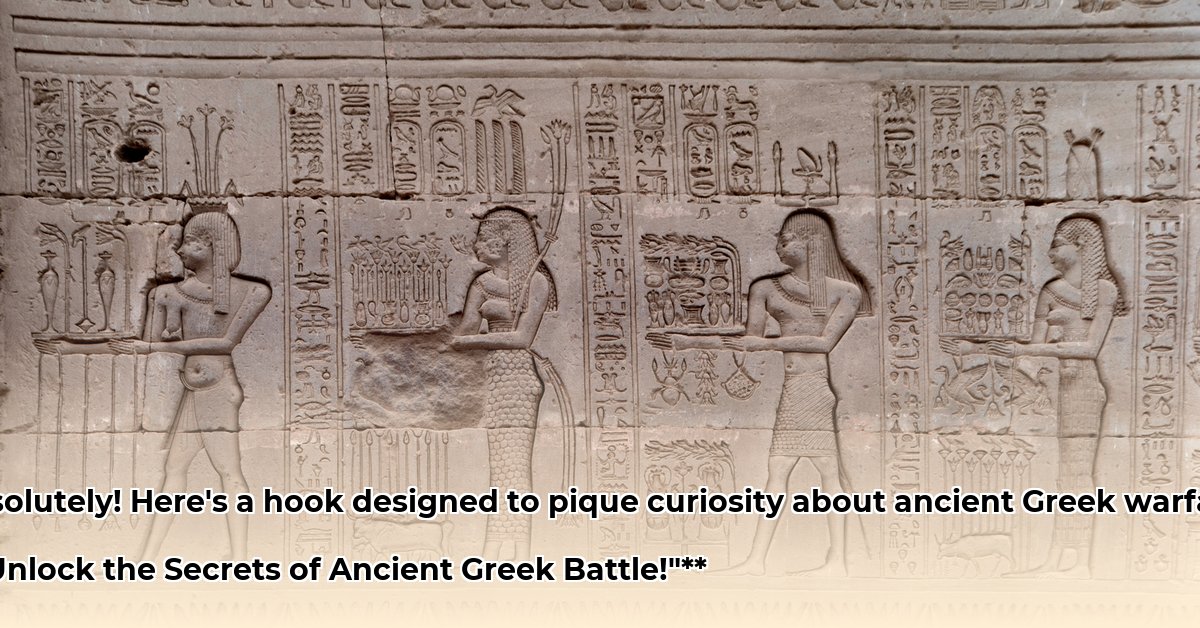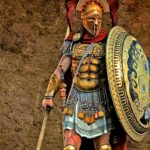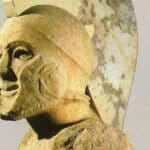Ever wondered how the ancient Greeks transformed from disparate communities into formidable military powers whose innovations profoundly shaped world history? This comprehensive guide delves into the intricate evolution of ancient Greek warfare, from its early, often brutal, forms to the highly organized and technologically advanced campaigns that defined its zenith. We will explore the iconic military doctrines, such as the disciplined hoplite phalanx and the agile trireme warship, and uncover the strategic brilliance, as well as the inherent limitations, that characterized their military endeavors. Prepare to navigate the fascinating and surprisingly relevant landscape of ancient Greek military thought, where timeless principles of strategy, leadership, and adaptability hold profound lessons for contemporary analysis. You can explore the evolution of Greek weapons to understand their power.
The Genesis of Greek Warfare: From Individual Valor to Collective Might
The earliest forms of warfare in ancient Greece, as depicted in Homeric epics like The Iliad, often emphasized individual heroic duels and skirmishes by nobles fighting from chariots. This period, characterized by constant feuds between tribes and opportunistic raids, lacked a unified military structure or sophisticated battle plans. Battles frequently paused for single combats between prominent leaders, whose outcomes could sway the morale of entire armies. Cruelty toward fallen enemies, including the desecration of corpses and enslavement of captives, was commonplace, yet instances of profound self-sacrifice and camaraderie within one’s own countrymen also emerged.
However, as city-states (poleis) consolidated power during the Archaic period (c. 800-500 BCE), warfare transitioned from private ventures to state-controlled operations. Citizen militias, comprising part-time soldiers who often provided their own equipment, became the backbone of these new armies. Assemblies or elite citizen groups sanctioned war, and elected generals (strategoi) were held accountable for their military actions. This shift embedded military service within the very fabric of citizenship, transforming it into a mark of status and a means of attaining glory.
The archon Solon’s reforms in early 6th century BCE Athens illustrate this societal impact. Military responsibility was stratified by economic class: the wealthiest (pentakosiomedimnoi) supplied leaders, the hippeis (horsemen) served as cavalry, the zeugitai could afford hoplite equipment, and the poorest thetes served as oarsmen in the fleet or light-armed troops. This integration of economic standing with military role underscored that warfare was no longer solely the domain of a warrior elite but a civic duty shared across society.
The Hoplite Phalanx: Greece’s Indomitable Land Force
The hoplite, a heavily armed infantry soldier, became the quintessential figure of Greek land warfare from the 8th century BCE onward. His signature equipment, the “panoply,” weighed approximately 70 pounds, primarily bronze. Key components included:
- Aspis (Hoplon): A large, circular bronze-faced wooden shield (around 30 inches in diameter). Carried on the left arm, it protected the hoplite and partially overlapped with the shield of the soldier to his immediate left, forming a continuous defensive wall. This was considered the most vital piece of equipment.
- Dory: A long thrusting spear (8-10 feet with an iron tip and butt-spike).
- Xiphos: A short sword for close-quarters combat, used if the spear broke or was lost.
- Bronze Armor: Typically a helmet (Corinthian, Illyrian, Chalcidian, or later open-faced pilos), a cuirass (chest armor, initially solid bronze, later lighter leather or laminated linen linothorax), and greaves (shin guards). Ankle guards offered additional protection.
The hoplite’s effectiveness lay in the phalanx formation: a dense, rectangular unit of soldiers typically 8 to 12 men deep (though Theban general Epaminondas famously deepened his flank to 50 men). Advancing shoulder-to-shoulder, their overlapping shields created a nearly impenetrable wall of bronze and spear points. This formation prioritized collective strength and discipline over individual heroism, making it exceptionally difficult to break.
Despite its formidable strength, the phalanx had vulnerabilities. Its flanks were exposed, and it required flat terrain for optimal deployment. The entire formation also tended to drift right as each soldier sought the protection of his neighbor’s shield, which could create gaps in the line or expose the right flank.
Different city-states adapted the phalanx to their unique cultures. Sparta, renowned for its militaristic society and rigorous agoge training system from age seven, produced an elite, highly disciplined professional army known for its lighter, more maneuverable armor. Their shields were emblazoned with the letter lambda for Lacedaemonians. Other states like Athens maintained smaller professional forces (logades or epilektoi) augmented by citizen levies when necessary.
Pivotal Battles Demonstrating Phalanx Prowess:
- Battle of Marathon (490 BCE): Athenian hoplites decisively defeated a larger Persian force, showcasing the phalanx’s frontal assault effectiveness.
- Battle of Thermopylae (480 BCE): King Leonidas and his 300 Spartans, alongside other Greek allies, used the narrow terrain to negate Persian numerical superiority, highlighting the phalanx’s defensive power.
- Battle of Plataea (479 BCE): The combined Greek hoplite forces delivered the final land victory against the Persians, confirming the phalanx’s dominance.
Evolution of Land Warfare Beyond the Phalanx:
The era of static, head-on hoplite clashes gave way to more mobile and multi-weapon warfare. Lighter-armed troops like peltasts (armed with short javelins and lighter armor), psiloi (javelin throwers – akonistai, archers – toxotoi, and slingers – sphendonētai using stones or lead bullets) became crucial for harassing enemies and complementing hoplites. Cavalry (hippeis) was deployed but in limited numbers due to high costs and Greece’s rugged terrain (Athens, with the largest force during the Peloponnesian Wars, had only 1,000 mounted troops). Decisive cavalry offensives primarily emerged with the Macedonians.
Tactical innovations also appeared:
* Oblique Formation: Theban general Epaminondas famously concentrated forces on one flank to shatter the opposing phalanx, as seen at Leuctra (371 BCE) and Mantineia (362 BCE).
* Defensive Square (plaision): Used effectively by Spartan general Brasidas (423 BCE) and the Athenians in Sicily (413 BCE) for both defense and offensive maneuvers.
Naval Supremacy: The Trireme’s Reign Over the Waves
Control of the sea was as crucial as land dominance for many Greek city-states, particularly Athens. The trireme, a light, highly maneuverable warship, became the pinnacle of Greek naval power from the 6th to 4th centuries BCE. Approximately 35 meters long with a 5-meter beam, it featured three banks of oars, requiring around 170 rowers (often poorer citizens called thetes) to propel it up to 9 knots. Its primary weapon was a bronze battering ram at the bow, designed to disable enemy vessels.
Tactical Brilliance of Trireme Warfare:
Naval battles centered on ramming rather than boarding. Commanders arranged fleets in long fronts to prevent enemy ships from passing behind them (periplous) or through gaps (diekplous).
* Diekplous: A rapid dash through the enemy’s formation, turning to ram their vulnerable sides or sterns.
* Periplous: Outflanking the enemy to attack from the rear or unprotected sides.
These sophisticated maneuvers demanded exceptional coordination among rowers and highly trained contingents of hoplites and archers on board. The Battle of Salamis (480 BCE), where the Athenian fleet skillfully outmaneuvered and defeated Xerxes’ invading Persian fleet, stands as a testament to trireme tactical superiority.
Economic and Societal Impact of Naval Power:
Triremes were incredibly expensive to construct and maintain, symbolizing that warfare had become a significant state concern, though wealthy private citizens often funded much of the expense. The immense undertaking spurred economic growth through shipbuilding, metallurgy, and the constant demand for rowers. This widespread employment, particularly for lower-class citizens, deeply integrated them into crucial state operations, reinforcing democratic ideals in Athens.
Despite their advantages, triremes had drawbacks: they lacked sleeping quarters, requiring drydocking each night to prevent waterlogging and protect the wood. Their eventual decline came as larger, more heavily armed warships with greater structural resilience emerged during the Hellenistic period. However, the trireme’s innovative design and tactical principles profoundly influenced subsequent naval architecture and strategy for centuries.
Strategic Innovations and Siege Warfare
Ancient Greek strategy evolved far beyond simple pitched battles on open plains. As conflicts became more protracted and complex, sieges, ambushes, and urban combat became increasingly common.
Pre-Battle Rituals and Gentlemanly Conduct:
Before engaging in battle, religious rituals were paramount. The will of the gods was sought through oracle consultations (e.g., Apollo at Delphi) and animal sacrifices (sphagia), where diviners (manteis) read omens from the victim’s liver. Unfavorable signs could delay battle. Fighting was also prohibited during major religious festivals and Panhellenic games. Opposing armies sometimes patiently waited on a suitable plain, singing hymns (paian) to Apollo before advancing. This “gentlemanly” approach gradually yielded to more subtle strategies and deceptions.
Fortifications and Sieges:
Most Greek city-states possessed a fortified acropolis for refuge. As warfare evolved, cities protected their suburbs with extensive fortification walls. Lookout towers in the countryside and frontier forts sprang up in response to increased attack risks. Famous examples include Athens’ Long Walls, spanning 7 km to Piraeus, creating a protected corridor to its harbor.
Early siege warfare primarily aimed to starve the enemy into submission. Offensive strategies using simple battering rams and earthen ramps were often unsuccessful against strong walls. However, the 4th century BCE brought significant technical innovations:
* Wheeled Siege Towers: First used by Carthaginians and adopted by Dionysius I of Syracuse against Motya (397 BCE).
* Artillery:
* Gastraphetes: Bolt-throwing artillery (a large crossbow).
* Lithoboloi: Stone-throwing apparatus.
* Flame-throwers: Used at Delion (424 BCE).
* Torsion Artillery: From 340 BCE, these advanced machines could propel 15 kg stones over 300 meters, finally enabling the breaching of city walls.
Defenders responded with thicker, stronger walls, often with convex surfaces to deflect missiles, and sophisticated counter-siege tactics:
* Fire Warfare: Pouring pitch onto attackers, followed by bundles of tow and sulfur, then burning wood chips to ignite the sticky mixture, creating inextinguishable fires and suffocating sulfur dioxide fumes.
* Wooden Bombs: Iron-spiked bombs filled with explosive material could be dropped onto siege engines, their spikes holding the flaming device in place.
Unconventional Warfare:
* Chemical Warfare: The earliest documented case occurred during the First Sacred War (c. 590 BCE), when the Amphictyonic League, possibly under Solon’s plan, poisoned the water supply of Kirrha with hellebore, causing severe debilitating illness among the besieged. This highlights the early use of biological agents and their indiscriminate impact on combatants and civilians.
* Tunnel Warfare: Used since the 9th century BCE, Greeks adopted and refined techniques of undermining walls. They also employed countermines—defensive tunnels to locate or block enemy tunneling. During a battle in 189 BCE, ancient Greeks famously burned chicken feathers to smoke out Roman invaders from tunnels. Sophisticated chemical counter-tactics, like the Persian use of burning sulfur and bitumen in tunnels against Romans at Dura-Europos, show the deadly ingenuity of ancient engineers.
Logistics, Spoils, and the Human Dimension
Maintaining an army in the field was a perpetual challenge for the Greeks due to poor logistics. Soldiers usually carried their own three-day rations (dried fish and barley porridge), often accompanied by a slave (skeuophoroi) acting as a baggage porter. Only the Spartan army had dedicated medical officers (iatroi); otherwise, slaves attended the wounded. Campaigns were typically fought in summer, minimizing the need for tents. Food could be pillaged from enemy territory, and later, ships, wagons, and mules (managed by older men) augmented supply lines for larger equipment.
War booty, though not always the primary motive, was a crucial benefit for victors, offsetting campaign costs and providing payment for troops. It encompassed territory, money, precious materials, weapons, and armor. Defeated men might be executed or sold into slavery, a common fate for women and children. A portion (10%, a dekaten) was typically dedicated to the gods at sanctuaries like Delphi or Olympia, which became vast treasuries of military material.
Victorious armies performed important rituals, including recovering their dead and erecting a victory trophy (tropaion) at the battle’s turning point. These trophies, made of captured arms or an image of Zeus, served as monuments. Speeches, festivals, sacrifices, and games often accompanied celebrations of victory.
The Zenith: Philip II and Alexander the Great
Greek warfare reached its apex with the Macedonian leaders Philip II and his son Alexander the Great in the mid-4th century BCE. Learning from and building upon earlier Greek strategies and technological innovations, they fundamentally transformed the battlefield:
* Sarissa: Philip introduced this exceptionally long spear or pike (up to 20 feet) for his Macedonian phalanx, giving it an unparalleled reach advantage.
* Combined Arms: They masterfully marshaled diverse troop units, fully exploiting cavalry and lighter-armed troops to work in concert with the phalanx. Alexander is credited with perfecting the cavalry charge.
* Superior Artillery: They incorporated and advanced siege artillery, including improved torsion engines capable of breaching city walls.
* Logistics: Far superior logistical organization enabled longer, more sustained campaigns across vast territories.
* Intelligence: Alexander notably relied on spies, even purportedly intercepting his own soldiers’ mail. He also required his soldiers to be cleanly shaven, ostensibly to prevent enemies from grabbing their beards in combat.
These innovations allowed Alexander not only to dominate Greece but also to conquer vast swathes of Asia, setting the pattern for warfare through the Hellenistic and into Roman times. His campaigns involved numerous sieges and decisive open-country battles, showcasing a blend of traditional Greek discipline and revolutionary tactical foresight.
Enduring Lessons: Strategic Principles for the Modern Era
The study of ancient Greek warfare offers profound insights applicable to modern fields, from military strategy to leadership and organizational management. By examining their successes, adaptations, and failures, we can distill timeless principles.
| Stakeholder Group | Short-Term Applications (0-1 Year) | Long-Term Strategic Developments (3-5 Years) |
|---|---|---|




![Unveiling Ancient [black people in ancient greece]: New Civilizations Insights, Challenging History black_people_in_ancient_greece_edited](https://www.lolaapp.com/wp-content/uploads/2025/08/black_people_in_ancient_greece_edited-150x150.jpg)











